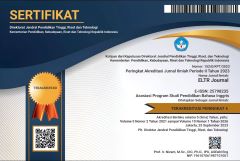IS LEARNING ENGLISH BORING WITH GAMIFICATION?
Abstrak terlihat: 1292 / PDF terunduh: 1094DOI:
https://doi.org/10.37147/eltr.v6i1.129Keywords:
EFL learners, gamification, motivation, student teachersAbstract
COVID-19 is a global pandemic that has brought significant disruptions to education. EFL educators ought to be aware of suitable methods during hybrid learning. The Digital learning trend that is reshaping EdTech for Gen-Z is gamification. It is the application of game-design elements and game principles in non-game contexts. Thus, this study aims to shed light on student teachers' perceptions on gamification for boostering motivation in hybrid language classes. To assess the perception, we tracked it of 32 students. Critical aspects highlighted by students in their learning experience were also analyzed. Evidences show the usefulness of gamification in improving students’ motivation and, to some extent, in changing their habits.
Downloads
References
Brown, H. D. (1994). Principles of Language Learning and Teaching (3rd ed.). Englewood Cliffs, New Jersey: Prentice Hall Regents.
Brown, H. D. (2003). Developing Faculty to use Technology. Balton, Anker Publishing company.
Brown, H. D. (2007). Teaching by principles: An interactive approach to language pedagogy (2nd ed.). White Plains, NY: Longman.
Buckley, P., & Doyle, E. (2014). Gamification and student motivation. Interactive Learning Environments, 24(6), 1162-1175
doi:10.1080/10494820.2014.964263
Callan, R. C., Bauer, K. N., & Landers, R. N. (2014). How to avoid the dark side of gamification: Ten business scenarios and their unintended consequences. Gamification in Education and Business, 553-568. doi:10.1007/978-3-319-10208-5_28
Caponetto, I., Earp, J., & Ott, M. (2014). Gamification and education: A literature review. Proceedings of the European Conference on Games-based Learning, 50–57. Retrieved on March 7, 2021, from
https://www.researchgate.net/publication/266515512_Gamification_and_Education_a_Literature_Review
Deterding, S., Sicart, M., Nacke, L., O'Hara, K., & Dixon, D. (2011). Gamification. using game-design elements in non-gaming contexts. Proceedings of the 2011 Annual Conference Extended Abstracts on Human Factors in Computing Systems - CHI EA '11. doi:10.1145/1979742.1979575
Domínguez, A., Saenz-de-Navarrete, J., De-Marcos, L., Fernández-Sanz, L., Pagés, C., & Martínez-Herráiz, J. (2013). Gamifying learning Experiences: Practical implications and outcomes. Computers & Education, 63, 380-392. doi:10.1016/j.compedu.2012.12.020
Figueroa, J. (2015). Using Gamification to Enhance Second Language Learning. Digital Education Review, 21, 32-54. Retrieved on March 7, 2021, from http://greav.ub.edu/der
Garcia-Iruela, M., & Hijon-Neira, R. (2020). What perception do students have about the gamification elements? IEEE Access, 8, 134386-134392.
doi:10.1109/access.2020.3011222
Hamari, J., Koivisto, J., & Sarsa, H. (2014). Does gamification work? -- a literature review of empirical studies on gamification. 2014 47th Hawaii International Conference on System Sciences. doi:10.1109/hicss.2014.377
Hol, D., & Ayd?n, I. (2020). Is technology in our classrooms? Efl teachers’ beliefs and engagement with technology in the classroom. Journal of Educational Issues, 6(2), 38. doi:10.5296/jei.v6i2.17326
Jusuf, H. (2016). Penggunaan Gamifikasi dalam Proses Pembelajaran, Jurnal TICOM, 5(1), 1-6. Retrieved on March 6, 2021, from
https://media.neliti.com/media/publications/92772-ID-penggunaan-gamifikasi-dalam-proses-pembe.pdf
Kalanzadeh, G. A., Soleimani, H., & Bakhtiarvand, M. (2014). Exploring the influence of using technology on Iranian EFL STUDENTS’ Motivation. Procedia - Social and Behavioral Sciences, 98, 814-823.
doi:10.1016/j.sbspro.2014.03.486
Kapp, K. M. (2012). The gamification of learning and instruction: Game-based methods and strategies for training and education. San Francisco: Pfeiffer.
Korn, O., & Schmidt, A. (2015). Gamification of Business Processes: RE-DESIGNING work in production and service industry. Procedia Manufacturing, 3, 3424-3431. doi:10.1016/j.promfg.2015.07.616
Lee, J. J., & Hammer, J. (2011). Gamification in education: What, how, why bother? Academic Exchange Quarterly, 15(2), 11–15. Retrieved on March 6, 2021, from
https://www.researchgate.net/publication/258697764_Gamification_in_Education_What_How_Why_Bother
Majuri, J., Koivisto, J., & Hamari, J. (2018). Gamification of education and learning: A review of empirical literature. GamiFIN Conference, Pori, Finland. Retrieved on March 6, 2021, from http://ceur-ws.org/Vol-2186/paper2.pdf
New Media Consortium horizon report on technology and higher education. (2014). Retrieved on March 5, 2021, from http://www.nmc.org/publication/nmc-horizon-report-2014-higher education-edition/
Peng, W., Lin, J., Pfeiffer, K. A., & Winn, B. (2012). Need satisfaction supportive game features as motivational determinants: An experimental study of a self-determination theory guided exergame. Media Psychology, 15(2), 175-196. doi:10.1080/15213269.2012.673850
Preist, C., Massung, E., & Coyle, D. (2014). Competing or aiming to be average? Proceedings of the 17th ACM Conference on Computer Supported Cooperative Work & Social Computing. doi:10.1145/2531602.2531615
Sailer, M., Hense, J. U., Mayr, S. K., & Mandl, H. (2017). How gamification motivates: An experimental study of the effects of specific game design elements on psychological need satisfaction. Computers in Human Behavior, 69, 371-380. doi:10.1016/j.chb.2016.12.033
Seixas, L. D., Gomes, A. S., & De Melo Filho, I. J. (2016). Effectiveness of gamification in the engagement of students. Computers in Human Behavior, 58, 48-63. doi:10.1016/j.chb.2015.11.021
Smith-Robbins, S. (2011). “This game sucks”: How to improve the gamification of education. Educause Review, 46(1), 58–59. Retrieved on March 8, 2021, from https://er.educause.edu/articles/2011/2/this-game-sucks-how-to-improve-the-gamification-of-education
Suwanmolee, S., & Ali, A. H. (2021). The Gamification of Covid-19 Pandemic as an Active Learning Tool in Disaster Education. Proceedings of the 6th UPI International Conference on TVET 2020 (TVET 2020).
doi:10.2991/assehr.k.210203.149
Werbach, K., & Hunter, D. (2012). For the win: How game thinking can revolutionize your business. Philadelphia: Wharton Digital Press.
Yilmaz, M., & O’Connor, R. (2016). A Scrumban integrated gamification approach to guide software process improvement: A Turkish case study. Tehnicki Vjesnik - Technical Gazette, 23(1). doi:10.17559/tv-20140922220409
Downloads
Published
How to Cite
Issue
Section
License
Copyright (c) 2022 Muhamad Laudy Armanda, Lilia Indriani

This work is licensed under a Creative Commons Attribution-ShareAlike 4.0 International License.













